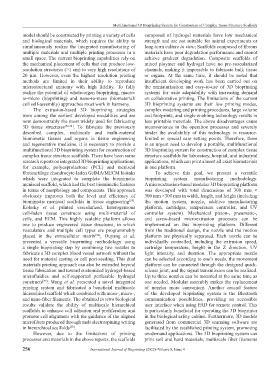Page 264 - IJB-8-4
P. 264
Multifunctional 3D Bioprinting System for Construction of Complex Tissue Structure Scaffolds
model should be constructed by printing a variety of cells composed of hydrogel materials have low mechanical
and biological materials, which requires the ability to strength and are not suitable for animal experiments or
simultaneously realize the integrated manufacturing of long-term culture in vitro; Scaffolds composed of fibrous
multiple materials and multiple printing processes in a materials have poor degradation performance and cannot
small space. The current bioprinting capabilities rely on achieve gradient degradation. Composite scaffolds of
the mechanical placement of cells that can produce low- mixed ploymer and hydrogel have no pre-vascularized
resolution structures (>1 cm) to very high resolutions of channels, making it impossible to fabricate bulk tissue
20 μm. However, even the highest resolution printing or organs. At the same time, it should be noted that
methods are limited in their ability to reproduce insufficient developing work has been carried out on
microstructural anatomy with high fidelity. To fully the miniaturization and easy-to-use of 3D bioprinting
realize the potential of whole-organ bioprinting, macro- systems for wide adaptability with increasing demand
to-micro (bioprinting) and nano-to-meso (biomaterial/ on collaborative printing. The limitations of the current
cell self-assembly) approaches must work in harmony. 3D bioprinting systems are their few printing modes,
The extrusion-based 3D bioprinting strategies complex modeling and printing procedures, large volume
were among the earliest developed modalities and are and footprints, and single enabling technology results in
now demonstrably the most widely used for fabricating less printable materials. The above disadvantages cause
3D tissue structures [52-54] . To fabricate the previously inconvenience in the operation processes and severely
described complex, multiscale and multi-material hinder the availability of this technology in resource-
biomimetic tissues and organs in tissue engineering limited or special care setting points. Therefore, there
and regenerative medicine, it is necessary to provide a is an urgent need to develop a portable, multifunctional
multifunctional 3D bioprinting system for construction of 3D bioprinting system for construction of complex tissue
complex tissue structure scaffolds. There have been some structure scaffolds for laboratory, hospital, and industrial
research reports on integrated 3D bioprinting applications, applications, which can print almost all exist biomaterials
for example, polycaprolactone (PCL) and meniscal in one platform.
fibrocartilage chondrocyte-laden GelMA/MECM bioinks To achieve this goal, we present a versatile
which were integrated to complete the biomimetic bioprinting system manufacturing methodology.
meniscal scaffold, which had the best biomimetic features A microextrusion-based modular 3D bioprinting platform
in terms of morphology and components. This approach was developed with total dimensions of 300 mm ×
obviously improves both the level and efficiency of 300 mm ×300 mm in width, length, and height (including
biomimetic meniscal scaffolds in tissue engineering . the motion system, nozzle, additive manufacturing
[55]
Kolesky et al. printed vascularized, heterogeneous platform, cartridges, temperature controller, and UV
cell-laden tissue constructs using multi-material of controller system). Mechanical piston-, pneumatic-,
cells, and ECM. This highly scalable platform allows and screw-based microextrusion processes can be
one to produce engineered tissue structures, in which implemented on this bioprinting platform. Different
vasculature and multiple cell types are programmably from the traditional design, the nozzle and the motion
placed in the extracellular matrix ; Ouyang et al. platform are physically separated. Each nozzle can be
[56]
presented a versatile bioprinting methodology using individually controlled, including the extrusion speed,
a single bioprinting step by combining two nozzles to cartridge temperature, height in the Z direction, UV
fabricate a 3D complex blood vessel network without the light intensity, and duration. The appropriate nozzle
need for material casting or cell post-seeding. This dual can be selected according to one’s needs, the movement
materials printing approach can also be extended beyond platform can be connected through the designed quick-
tissue fabrication and toward customized hydrogel-based release joint, and the signal transmission can be realized.
microfluidics and self-supported perfusable hydrogel Up to three nozzles can be mounted at the same time as
constructs ; Wang et al. presented a novel integrated one needed. Modular assembly makes the replacement
[57]
printing system and fabricated a beneficial multiscale of nozzles more convenient. Another crucial feature
hierarchical scaffold which combined with meso-, micro-, of the developed bioprinting system is the Bluetooth
and nano-fiber filaments. The obtained in vitro biological communication possibilities, providing an accessible
results validate the ability of multiscale hierarchical user interface when using PAD for remote control. This
scaffolds to enhance cell adhesion and proliferation and is particularly beneficial for operating the 3D bioprinter
promote cell alignment with the guidance of the aligned in the biological safety cabinet. Furthermore, 3D models
microfibers produced through melt electrospining writing generated from commercial 3D scanning software are
in hierarchical scaffolds . facilitated by the established printing system, promoting
[58]
However, due to the limitations of printing on-demand applications. The 3D bioprinting system can
processes and materials in the above reports, the scaffolds print soft and hard materials, multiscale fiber filaments
256 International Journal of Bioprinting (2022)–Volume 8, Issue 4

